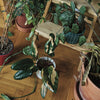Aglaonema, a grateful maid for beginners

The genus Aglaonema includes more than 50 species of plants and is also known as the "Sleeping Virgin" or the Chinese evergreen plant. It is a popular indoor plant with attractive leaves and the ability to survive in low light conditions. Aglaonemas are native to the tropical regions of Southeast Asia, specifically Malaysia and the Philippines, where they are among the most popular houseplants. These plants are popular for their decorative appearance as well as their ability to clean the air of harmful substances.
One of the main reasons people choose Aglaonemas is their ability to survive in lower light conditions. This plant can thrive even in rooms that have little direct light, making it ideal for apartments and offices with limited access to natural light. Aglaonemas need a light to semi-shaded environment for their growth , direct sunlight could damage their leaves.
Another advantage of Aglaon is their ability to clean the air . This plant is known for its filtering properties that help remove harmful substances from the air. Aglaonemas can absorb substances such as formaldehyde, benzene and carbon dioxide, which can help create a healthier and cleaner indoor environment.
A good choice for beginners
Aglaonemas belong to very undemanding maids and are therefore suitable for complete beginners who do not want to devote more time to their maids. A big advantage is that aglaonemas are also very resistant plants with stiff leaves that can retain water for a little longer. So, if you sometimes forget about them with the dressing, they probably won't die, and if you pour it over, it's more likely that nothing will happen to them. They can be placed almost anywhere in the apartment except in direct sunlight or in complete darkness.
Aglaonemas belong to the group of Aroid plants, which also includes monsters, philodendrons, syngonia and others. They are therefore poisonous, but not so much that you have to worry about having them at home with animals or small children.

Photo: Aglaonema Lemon Mint 'Key Lime'
Not very common species
Aglaonemas are not as widespread a species as some others. There are roughly over 50 types of plants and in most cases they are medium-sized plants that do not have large leaves like, for example, monsters. They are therefore suitable for ordinary apartments and do not need to devote a lot of space to them. The disadvantage of these plants is the higher purchase price, even for small plants, because it is a slow-growing houseplant.
Among the best-known species in our region are Aglaonema Maria and Aglaonema Cutlass. In their varied offer, you will also find more colorful plant species with interesting leaf colors, e.g. Aglaonema Electric Lime or Aglaonema Lemon Mint and many species with pink to red color, e.g.Aglaonema Red Zircon .
How to care for aglaonemas?
Aglaonemas are very hardy, they can withstand heat and a colder room, overflow and drought, and at the same time they are not demanding on the humidity in the apartment or the light conditions. Let's take a look at the most ideal conditions for these plants to grow beautifully in your home.

What environment suits them and how much light?
Aglaonemas prefer temperatures between 20-25 °C (68-77 °F) during the day. They are sensitive to icy drafts and sudden temperature changes, so it is important to maintain a stable temperature in their surroundings. Avoid placing Aglaon near cold windows or doors in the winter months or near air conditioning equipment. Icy air can completely destroy the leaves. Especially when buying these plants in the winter months, pay attention to the condition of the plant, if it has noticeable brown spots on the edges of the leaves or yellowing leaves, it is likely that it has been through a frost and is suffering from leaf rot.
The location will therefore love more light without direct sun, especially more colored species with variegated or pink shades. The dark green species are more satisfied with partial shade. She will be happy in a more humid environment, but she will also be satisfied with a normal room climate.
Top dressing and fertilizing
Aglaonemas are not demanding on nutrients in the soil, so they will appreciate any common fertilizer for green plants that will support their growth. Because Aglaonemas bloom relatively easily even in our apartments with inconspicuous inflorescences, usually from spring, but autumn is no exception, treat them with fertilizers with a higher nitrogen content rather than fertilizers that support flowers. In these types of plants, the flowers are not the main thing to admire and they take energy from the plant.
It is enough to water the plant once a week as standard, but if you water more, it will be satisfied with watering once every 14 days. When watering Aglaonema, try to keep the soil evenly moist, but avoid overwatering, which could lead to root rot. In the warm months, beware of drying too quickly. The plant is also one of the easiest plants to transfer to hydroponic cultivation thanks to its roots, which are very well cleaned of the rest of the substrate, and this plant thrives very well in hydroponics.

Photo: Aglaonema White Lance
What is the suitable substrate for aglaonema?
A suitable substrate for Aglaonema should be well permeable, light and at the same time able to retain moisture. It is recommended to use a mixture of garden soil, peat and perlite or sand. The substrate should be of good quality and rich in nutrients.
Perlite or sand is added to the substrate to improve drainage and prevent excessive moisture retention. These materials help keep Aglaonema roots well-drained. You can also use a substrate for aroids .
In our offer you can also find other varieties of aglaon here .

Author: Martin Seidl
-
Posted in
Péče o pokojovky




